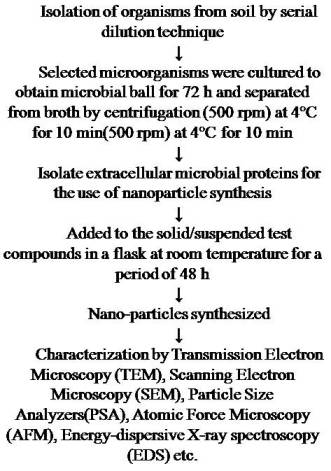कृषि मेें स्थायित्व के लिए जैवसंश्लेषण नैनोकणों का महत्व
Nanotechnology is one of the most important and recent tools in modern science yet only a few attempts have been made to apply these advances for increasing crop productivity. The nanotechnology technique may be the most hopeful and reassuring way to improve the overall agricultural production.
The potential applications of nanoparticles in agriculture sector include biosensors; gradual, time-consuming, and controlled delivery of chemical fertilizers and pesticides; detection and control of plant diseases; soil and water remediation; etc.
At present however the use and employment of nanotechnology in the agricultural field is in the infant stage; however, if discovered gradually and used in a sustainable way, this new technology can help in the orientation of our agriculture and society today to new heights in the future.
Biosynthesis of nanoparticles
Preparation of nano particles can be done by using physical, chemical and biological methods. Chemical method of synthesis is more useful as it takes short time for synthesis of bulk amount of nano particles.
The chemicals reagents used in chemical methods are toxic and lead to synthesis of by-products which are not environment friendly. Therefore, there is need of development of procedure which is eco-friendly and not requires any toxic material for the synthesis of nanoparticles. The methodology for nano particle synthesis from microorganisms is shown in Figure 1.
A variety of natural sources are there for metal nanoparticle synthesis including plants, fungi, yeast, actinomycetes, bacteria etc. The unicellular and multicultural organisms can produce intracellular and extracellular inorganic nanoparticles. Synthesis and Applications of Nanoparticles from/ with microorganisms have been shown in Table 1.

Figure 1: Methodology for nanoparticle synthesis from microorganisms
Bacteria have been most extensively researched for synthesis of nanoparticles because of their fast growth and relative ease of genetic manipulation. Cell-free culture supernatants of five psychrophilic bacteria Pseudomonas meridiana, Pseudomonas proteolytica, Pseudomonas antactica, Arthrobacterkerguelensis and Arthrobactergangotriensis and two mesophilic bacteria Bacillus indicus and Bacillus cecembensis have been used to synthesize silver nanoparticles (AgNPs). A low cost, ecofriendly approach using the fungi Aspergillus flavus TFR 7 for the biosynthesis of TiO2 nanoparticle (NPs).
Use of biosynthesized nanoparticles in agriculture
The intense problems confronting productivity in agriculture, such as several abiotic and biotic stress factors, require more precise and effective solutions; and products with higher efficacy are further required to mitigate the stress. Nano-technology can improve our understanding and also deliver better products. It can contribute to the development of improved systems for monitoring environmental conditions and delivering nutrients or appropriate pesticides and thus potentially enhance yields or nutritional values.
Thus, nanotechnology can be an important part of the further agriculture, food systems and industry. This frontier area of technology has potential to revolutionize in every sector of agricultural and food industry after providing Nanosensors for contaminant detection, water flow detection, disease diagnosis and tracking use of elite lines, breeds as well as cultivars; Nanomembranes for purification, desalination and detoxification; Nanoparticles for preparation of nanofertilizers, robust water tanks to prevent seepage, liquid and gaseous
Table1. Synthesis and Applications of Nanoparticles from Microorganisms
|
Microorganism |
Extracellular/ Intracellular |
Types of Nanoparticle |
Shapes |
Size (nm) |
Applications |
||
|
Fungi |
|||||||
|
Aspergillus flavus |
Extracellular |
TiO2 |
- |
12–15 nm |
Influence on mung bean as nutrient |
||
|
Bipolaristetramera
|
Extracellular |
Silver and gold
|
Silver (irregular) Gold (pherical or hexagonal |
Silver (54.78 nm to 73.49 nm) Gold (58.4 and 261.73 nm) |
antimicrobial, cytotoxic and immunomodulatory activity |
||
|
Trichoderma viride |
Extracellular |
Silver |
spherical and occasionally rodlike |
5-40 nm |
Nanoparticles incorporated into sodium alginate for vegetable and fruit preservation |
||
|
Bacteria |
|||||||
|
Spirulina platensis (AJ401120) |
Extracellular |
Silver |
Spherical |
50 nm |
Antimicrobial activity against Pseudomonas solanocearum, Pseudomonas syringae, Xanthomonasmalvacearum and Xanthomonascampestris |
||
|
Bacillus sp. GP-23 |
Extracellular |
Silver |
Spherical |
7-21 nm |
Antifungal activity against plant pathogenic fungus, Fusarium oxysporum |
||
|
Yeast |
|||||||
|
yeast strain MKY3 |
Extracellular |
Silver |
Hexagonal |
2–5 nm |
- |
||
|
Actinomycetes |
|||||||
|
Rhodococcussp |
Intracellular |
Gold |
Spherical |
5–15 nm |
- |
||
fuels-based lighting, cooking materials, pesticides, hormones, vaccines, solar cell panels; Nano catalysts for hydrogen generation etc.; Nanozeolites for efficient release of water, slow release of fertilizer particles; Nanomagnets for soil health testing, removal of soil contaminants; Nano-emulsions for enhancing shelf-life; Quantum dots for diagnosis; Nanoscale formulations of different food products for flavoring, refining catalytic devices in oils, dairy, meat, poultry products; Nanocomposite particles in packaging materials; Nanocapsules for better nutrient delivery, bioavailability. Nanotechnology gives strong impact on food preparation and conservation. It has great promise of sustainable development in long term and second green revolution.
Biosynthesized nanoparticles haveseveral merits as they are eco-friendly in nature, can increase three fold Nutrient Use Efficiency (NUE), 80-100 times less requirement than chemical fertilizer, 10 times more stress tolerant by the crops, 30% more nutrient mobilization in the rhizosphere, 17-54% improvement in crop yield and Improvement in soil aggregation (33-82%), moisture retention (10-14%) and C build up (2-5%) in the soil. There are several other applications of these nanoparticles in agriculture.
Conclusion and Future Prospects
Use of biosynthesized nanoparticles in agriculture sector is in its early stage but have incredibleprospective. Attention towards the improvement of the synthesis efficiency and control of particle size is needed. As the synthesis process by biological sources is relatively slow, compared to physical and chemical methods.
The reduction of synthesis time will make this biosynthesis process much more attractive. With the recent progress and the ongoing efforts in improving particle synthesis efficiency and exploring their biomedical and agricultural applications, it is hoped that the implementation of these approaches on a large scale and their commercial application will take place in coming years.
Authors
Dr. Kirti Saurabh
